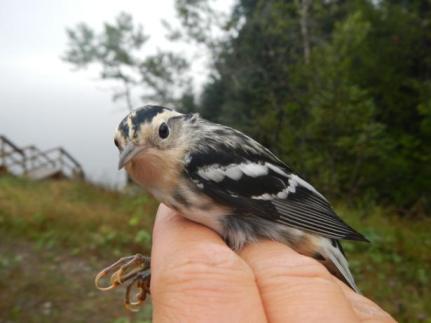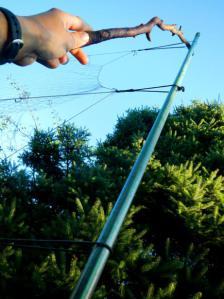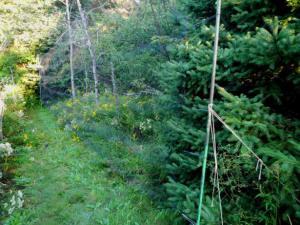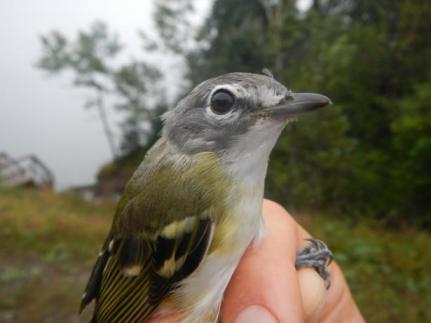Or, How to Catch a Bird in 6 Steps

Black-and-white Warbler (juvenile). St. Andrews, New Brunswick, September 2013.
***For those who don’t know what a mist net is, check out this informative, well-written, entertaining, engaging blog post: What Is A Mist Net?***
1. Get up early, as in before sunrise, and get yourself to your banding station. Nets need to be up and opened (able to catch birds) by about a half-hour after sunrise. Coffee is recommended.

The spreading of the trammels. Much consideration goes into choosing just the right stick for this purpose.
2. Set up your net. This will involve two 10 ft metal poles (electrical conduit poles work nicely) and a mist net. Slide the pole through one set of the end loops on the net, stand up the pole, and then walk down the net lane feeding out your net. Once all the net is stretched out, slip a pole through the other end and set it up.
2.5 If needed, tie guidelines from nearby trees, or stakes in the ground, to help keep your poles upright.
3. Spread out the trammels*. Make sure they aren’t twisted. Use a stick to get them up high enough.
4. Take a good look and make sure everything is set up right, that the net isn’t bunched up or stuck together, or too loose and saggy, and then go on to set up the rest of the nets.
5. Once all the nets are set up, check them at least every half-hour to see if you have caught any birds. If you have, gently untangle them, place them in a bird bag, and take them back to the banding station for processing.
6. Processing will be explained in detail in a following blog post, but here’s the short speal:
Once back at the banding station, we take a bunch of measurements/observations: wing length (called wing chord), weight, age, sex, how fat they are (by looking at the hollow below their neck, one of the places birds will store fat for migration), molt (are they growing in any feathers?), and flight feather wear (how raggedy are their wing feathers).

A mist net open and ready to catch birds.
It’s that simple!
Haha, just kidding. I wish.
Setting up mist nets extremely early in the morning is one of the few things that has the ability to make me instantly and irrationally angry. When the net is tangled, or your poles keep falling down before you can get them secured so the net falls on the ground and becomes a magnet for leaves and twigs you then must delicately remove, or when your stakes and ropes are missing, or when one of the trammels breaks… Let’s just say that I sometimes have the urge to chuck the net onto the ground, stomp on it until it’s dead, and then throw it in the river. And then punch a panda in the face. That’s how deep the rage can be.

I don’t care how cute you are. You’ve never set up a mist net, so you wouldn’t understand.
It takes lots of practice to be able to safely and quickly remove birds from mist nets, and to process them efficiently and quickly. Note the emphasis on quickly– being caught in a mist net is stressful enough, so we try to get the birds back on their ways ASAP while being as careful as we can while handling them.
As I’ve mentioned, I’m currently in Canada banding birds, so if anyone’s interested you should stop by the Huntsman Marine Centre and check out our banding station. I welcome the company!

Blue-headed Vireo. St. Andrews, New Brunswick, September 2013.
*refer to What Is A Mist Net?

